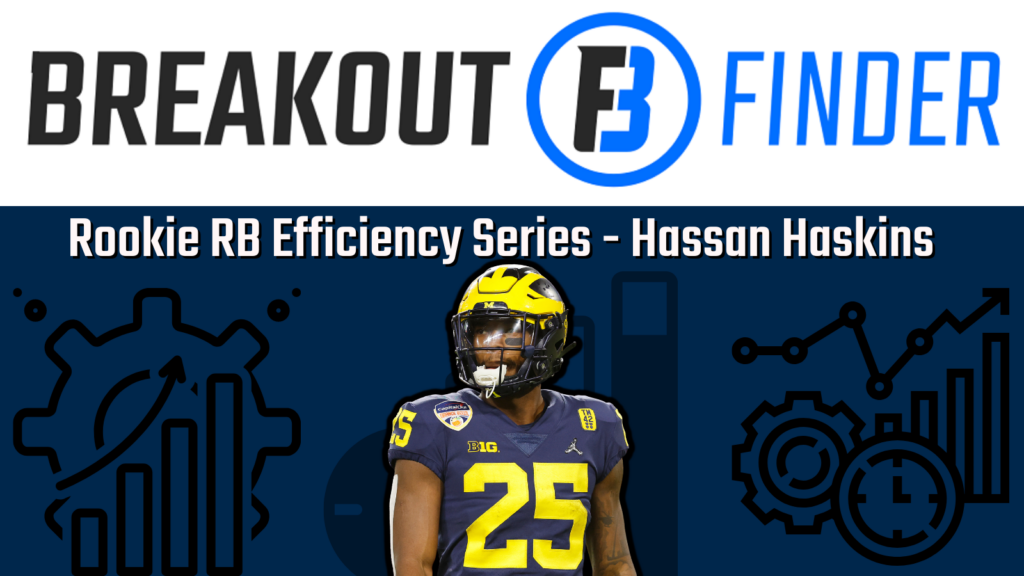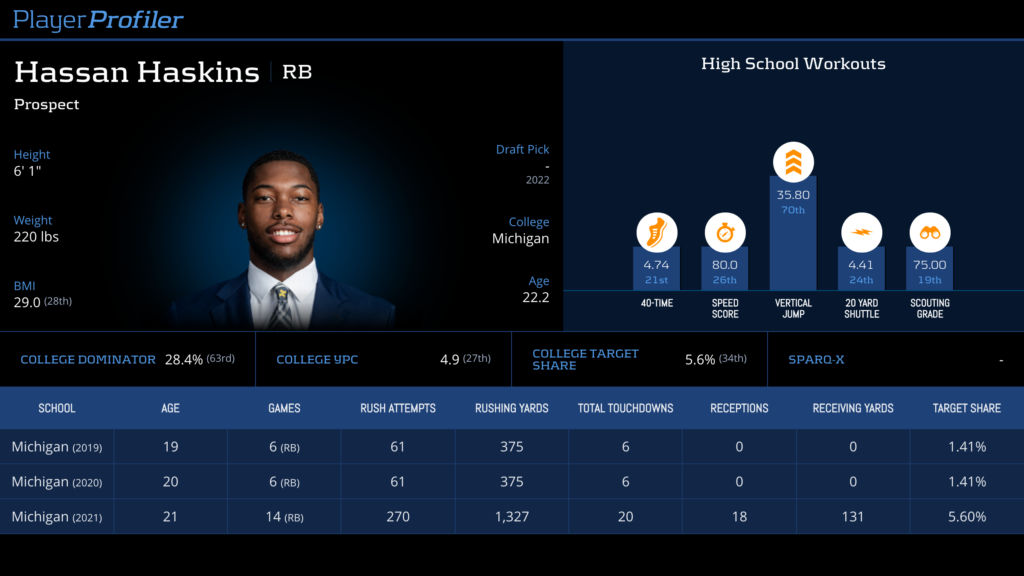Michigan’s Hassan Haskins is the next subject in a series in which I evaluate 2022 rookie running backs solely on their ability to run the ball. The Breakout Finder installments can be found here. The four PlayerProfiler installments can be found here. If you happened to already catch those and don’t need a refresher on my methodology, feel free to skip to the player-focused analysis.

During the two seasons that Zach Charbonnet spent as a Michigan Wolverine, Hassan Haskins was arguably the best running back on the team. While he didn’t see workhorse-level touches until Charbonnet jumped ship for UCLA in 2021, Haskins consistently outperformed a group of teammates that included Charbonnet and collectively averaged a 3.54-star rating as high school recruits during those first couple years.
The Metrics
On 182 carries in his two seasons, Hassan Haskins outdid that 61st-percentile (among teammates of running backs drafted since 2007) group of backfield mates by 0.92 yards per carry and 3.45-percent in Chunk Rate. Those numbers would put him in the 66th and 59th-percentiles, respectively, if they were career marks. And he was similarly impressive as a big-play runner during that timeframe. His Breakaway Conversion Rate over those seasons was 38.4-percent, an 82nd-percentile mark.
Things came back down to earth for Haskins when he took over as the clear lead guy, however. On 270 carries in 2021, his -1.20 YPC+ mark would be a 4th-percentile figure. His -1.42-percent Chunk Rate+ would not be much better, landing in the 27th-percentile. He also failed to convert chunk gains into breakaways at nearly the rate he did before. His 2021 BCR of just 16.7-percent would be a 5th-percentile number.
Side Note
I’m pretty wary of deciding that guys can or cannot “handle” a heavy workload. Much of what we see as demonstration of that ability often comes down to a few conflating factors; the randomness of injuries, biases involved in the scouting and draft selection process, preconceived notions that coaches have about what high-volume running backs should (literally) look like, and the (in my opinion) misunderstood dynamic that just because high-volume college runners often are the ones who turn out to be high-volume NFL runners, that’s probably because they are simply the best players, not because they are the only players capable of “handling” large workloads.
I say all of that to say that, while not definitive, the best evidence of a player who is incapable of handling a large workload is one whose rushing efficiency profile reads like Haskins’ does. As a committee member, he was a quality runner of the football. As the workhorse, he was abysmal.
On the aggregate, Haskins’ efficiency stats (and their percentile ranks) are as follows:
- YPC+: -0.35 (18th-percentile)
- Chunk Rate+: 0.54-percent (46th-percentile)
- Breakaway Conversion Rate: 25.4-percent (28th-percentile)

As a player with workhorse size (he was listed at 6-1, 220-pounds last season) and minimal receiving chops, Haskins is a classic two-down runner. It makes sense that he saw heavier box counts than those his teammates ran against. His were actually 0.24 defenders heavier than that of his teammates. This extreme discrepancy lands in the 93rd-percentile. And while he was more efficient than other Wolverine backs relative to those box counts, he only managed a 103.6-percent (20th-percentile) BAE Rating.
Rushing Efficiency Score and Comps
According to my model’s Rushing Efficiency Score (which accounts for all the non-BAE metrics considered here, in addition to overall team quality, rushing volume, strength of opponent, and offensive line play), Hassan Haskins earns a 41.0 out of 100. In a BAE-centric composite, he earns a 42.4. On the aggregate, and especially as a lead runner, he simply was not impressive from an efficiency standpoint.
My running back model also generates comps. Using the same metrics that contribute to the Rushing Efficiency Score in addition to physical measurables, Haskins’ most similar players from a “pure runner” standpoint (assuming he runs a 4.55 40-yard dash at right around 6-0, 220-pounds) are the following:

Spoiler alert: six out of 10 players overlap with players on Zamir White‘s comp list (article coming to PlayerProfiler soon). If I were to comp rookies to rookies, White would actually be Haskins’ second most comparable player.
Last Word
Players from big-time college programs simply get opportunity in the NFL. Even when it’s seemingly undeserved. Hassan Haskins was a fine college running back and he is now a mediocre professional running back prospect. But there’s a chance an NFL team sees the yellow wings on that navy blue helmet and gets all hot and bothered over the second coming of Matt Jones. The good news is that you don’t have to do the same thing. Just say no to the influence of drugs and college football programs with Jordan Brand sponsorship deals. Instead, get your highs the natural way; by selecting under-the-radar players with actual talent and upside in the fourth round of your rookie draft ahead of bad players with greater draft capital.


